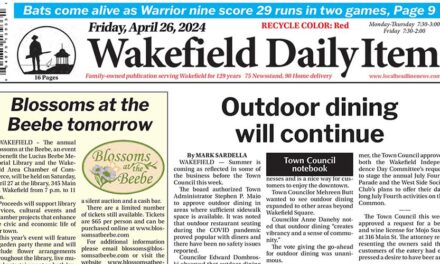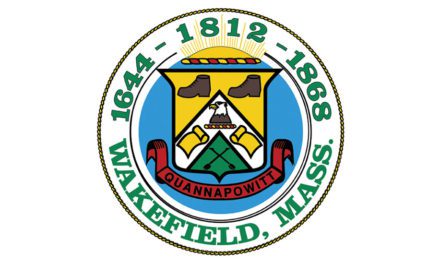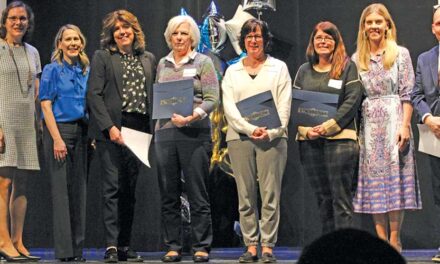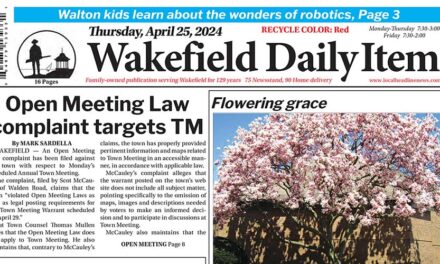Published in the November 2, 2016 edition
By MARK SARDELLA
WAKEFIELD – Consultant Peg Barringer of Finepoint Associates was back in town last night to once again review the results of a downtown market analysis that she did for the town last year. It was at least the third time that Barringer has publicly presented her findings and recommendations for revitalizing the downtown business district.
Last night’s session drew about 60 local residents and merchants to the The Savings Bank Theater at Wakefield Memorial High School.
Barringer was joined by Amanda Chisholm, chief economic development planner at Metropolitan Area Planning Council, who is working with the town as part of an MAPC grant to develop a strategy to expand the Albion Cultural Exchange and turn Albion Street into an arts and cultural district. A public meeting to share ideas related to that goal is scheduled for Thursday, Nov. 17 at 7 p.m. in Galvin Middle School cafeteria.
Barringer noted that despite the visibility of vacant storefronts, Wakefield’s downtown business district has a lower vacancy rate than the national average. She discussed the types of businesses in the downtown, observing that Wakefield had a larger percentage of businesses offering personal care and convenience goods than most downtowns and fewer healthcare and technical service establishments.
She noted that Wakefield has a charming and walkable town center that is exactly the model that developers of lifestyle centers like Lynnfield’s MarketStreet are trying to mimic.
She noted that consumers today are looking for “experiential shopping” that includes socializing and recreation. Along those lines, she recommended more outdoor/sidewalk dining and social spaces where people can sit and interact and maybe enjoy a street performer.
She acknowledged that the town is already doing some of the things in her original list of recommendations, such as the “First Thursday” events at the Albion Cultural Exchange. She talked about the economic impact of events, which can attract people to the downtown who will spend money.
Barringer discussed ways to leverage a unique town asset like Lake Quannapowitt to bring more people downtown by making sure that events held around the Lake incorporate some element of downtown promotion.
Barringer also talked about creating target nodes and clusters of businesses that complement each other to maximize traffic. She recommended creating a business recruitment brochure and adding a section to the town’s website where prospective new businesses can find information and help. She talked about the importance of making sure that existing businesses look open and inviting.
Chisholm spoke in general terms about capitalizing on Barringer’s recommendation of incorporating an arts component into the downtown as a way to draw people and potential customers to businesses. She encouraged people to attend the Nov. 17 meeting to help flesh out specific ideas for turning Albion Street into a cultural district.
Town Administrator Stephen P. Maio and Town Planner Paul Reavis joined Barringer and Chisholm in fielding questions from the audience.
A Pleasant Street resident wanted to know how the town planned to capitalize on the influx of new residents that will be moving into the downtown when the new Brightview Senior Living facility opens.
Reavis noted that the Zoning Board had insisted on a walking path from the back of the Brightview building out to Main Street to provide residents with the shortest and easiest access to the downtown. Maio said that the town would be working with Brightview on other ways to bring residents into the downtown.
Sara Guerin of Valley Street asked what kinds of things the town was doing to link Lake activities to the downtown. She noted that with the Rockery and the Monuments on the Common, there isn’t a visual connection to the downtown from the Lake direction.
Maio talked about a number of “low-tech” things that the Chamber of Commerce was working on to improve that connection, such as a restaurant guide and using kiosks around the Lake to promote the downtown.
Chisolm said that arts and culture installations along with signage can overcome some of those barriers and turn them into opportunities to form a creative connection between the Lake area and the downtown. Barringer suggested using signage and other means to encourage anther route for walkers in addition to walking around the Lake, one that would take them through the business district.
One resident observed that about half of the downtown was charming and inviting, but the other half less so and wondered what the town was doing to address it.
Maio said that the town has actively sought to work with downtown commercial landlords on improving their properties and recruiting suitable business tenants. But he noted that some landlords have been less receptive than others to the town’s overtures.
Maio did note the passage of a zoning measure designed to encourage mixed-use, residential above retail projects.
Another resident suggested that the street crossings in the downtown were too long and dangerous for pedestrians. She mentioned the idea of occasionally taking a couple of parking spaces and using them as a temporary outdoor seating area for a restaurant.
Reavis pointed out that a wholesale revamping to widen the sidewalks and narrow Main Street (similar to what Reading did) would require lowering the street, a massive and costly undertaking. He agreed that the crossing distance on Main Street was long but noted that there is limited ability to use “bump outs” due to the need to provide an adequate turning radius for fire engines.
Rada Frohlichstein, owner of Rada Boutique, stressed the importance of creating an inviting downtown ambience. She talked about lowering the height of the street lamps to bring more light and fixing up the sidewalks and improving the street. She said that the town needed to start acting, at least in small, ways to bring about its plans. She wondered if any of the town’s ample reserve funds could be used to jump start such an effort.
Maio said that he had no objection to the town helping out with small things like signage but he noted that expending any significant amount of town money would be up to Town Meeting voters.




